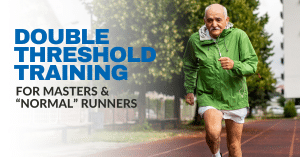“All that running will wreck your knees.”
Pretty much every runner has heard this one at least once (inevitably from a nonrunner). It’s common enough to have become something of a cliché, but is there any truth to it?
In the medical community, there is often a lot of concern that the chronic loading associated with running daily or nearly daily over many months and years can take a toll on the body, leaving runners more vulnerable to osteoarthritis—an irreversible degeneration of the cartilage in the joints of your body.
Arthritis affects millions of people in the United States and, when it affects the hip or knee, can require joint replacement surgery. So if running, especially high-volume training, can lead to an increased risk of osteoarthritis, it’s something that runners need to take into account.
As usual, we’ll look to scientific research to find some answers.
The research on the ways that running can impact joint health
The first study we’ll look at comes from N.E. Lane and co-workers at the University of California, San Francisco.1
Their 1998 study examined a group of 28 club runners from ages 51-68 over a period of nine years. The runners were compared to 27 non-running control subjects.
Every few years, all of the subjects in the study had x-rays taken of their knees and hips to check for early signs of osteoarthritis in the joint. Over the nine-year follow-up, the prevalence of osteoarthritis rose in both groups. Fortunately, however, there were no significant differences in the rate of knee or hip osteoarthritis between the runners and nonrunners.
While this is an encouraging finding, this study was quite small, and perhaps did not look at runners with a sufficiently level of high training.
A look at a larger research sample and its implications
To answer these challenges, we’ll look to a study by Roger Sohn and Micheli Lyle, which sampled a much larger pool of 504 former college runners and 287 former college swimmers.2
After following these subjects for many years (anywhere from two to 55 years after their careers had finished), Sohn and Lyle found a very similar rate of severe joint pain (presumably linked to osteoarthritis) in both the swimmers and the runners—2.4 percent to 2.0 percent. Fewer than one percent of the runners ended up having surgery for osteoarthritis.
This, again, is very good news for habitual runners. But can these types of studies successfully identify factors that are associated with the development of osteoarthritis?
Factors that influence osteoarthritis development for runners
One study which successfully did so was published by U.M. Kujala and colleagues at the Helsinki Research Insitute for Sports and Exercise Medicine in Finland.3 Their study, while smaller than that of Sohn and Lyle, examined former top level athletes in shooting, running, soccer, and weight lifting—all members of the study had been training for an average of at least 15 years; some had been at it for over sixty! Each of the subjects had represented Finland at at least one international competition (such as the Olympics, world championships, etc.). The shooters acted as a control group, as their sport presumably did not involve much high loading on their knee joint.
While each group had only around 30 subjects, the findings nevertheless showed that the incidence of knee osteoarthritis was 3 percent among shooters, 14 percent among runners, 29 percent among soccer players, and 31 percent among weight lifters. Because of the vagaries of small-number statistics, the difference in rates of arthritis between the runners and shooters were not statistically significant.
In their analysis, the authors blamed traumatic knee injuries and carrying a high-body weight for the increased risk of osteoarthritis in the soccer players and weight lifters, respectively.
A less optimistic view
While the results of all of the above studies are encouraging, serious athletes aren’t quite out of the woods. While some studies have connected high volumes of impact exercise with osteoarthritis in animals, the only one I’m aware of which has found such a result in runners is a 1989 study which examined a handful of top-level elite runners who had trained at a high level for several decades.4
Their incidence of hip osteoarthritis was higher and more severe than that of untrained men or former top-level bobsled riders.
While this study, like all small-sample-sized studies, has its limitations, it is one of the few that examines serious runners who trained at very high volumes; many of the subjects in this study maintained well over 60 miles a week for several years.
It’s not nearly enough evidence to discourage high-volume training, and Kujala, et al.’s paper on former international-caliber runners is a good rebuttal, but it does suggest that further research in this area to determine how it impacts joint health is needed.
Final thoughts on how running can impact joint health
Until then, very serious high-volume runners should be aware that there is a possibility this could increase their risk of hip osteoarthritis. Happily, however, for the vast majority of runners, there is no evidence at all that running puts you at a higher risk for arthritis of the knee.
Indeed, it’s a much safer activity for your joints than sports which carry a high risk of traumatic knee injury or carrying a high body mass index.









3 Responses
This is an eye opening post. Thanks. Is there any research on back joints?
I am 50 yo male. Like most males in this age group I suffered a sore back, and 4 years ago I started consistent running (2-3 times a week now up to 7-10km a session although I do a half marathon each year). Six years ago I had a back operation to “retread” a disc. I was advised by my surgeon not to run, but my MD said I could run slowly, occassionally, but never on an asphalt surface. It’s not possible to consistently find a non-asphalt surface, so I find myself running linear parks frequently and really enjoying the exercise.
Is there any research that will refine my behaviour?
Hi Ian,
Sorry to hear about your back issues and the surgery. That must be hard to go through. I personally haven’t seen research about this topic, but it might be out there. I’ll take a look these next few weeks and see if there is anything available.
My advice for now is to listen to your doctor and your body. While I know it would be great to increase your running, you don’t want it to be at the expense of your back. I do hope things can progress for you.
Genetics has to be factored in plus injuries. Into my sixties I could run but slower, a soccer referee. But at about sixty my knees lost their bounce and I now have one hip replacement and can hardly walk. So studies have to show long term effects, BMI and impact of early sports injuries. Would I rather be able to walk now than run twenty years ago, tough call, but if I see an older heavy man jogging I would recommend he walk instead.